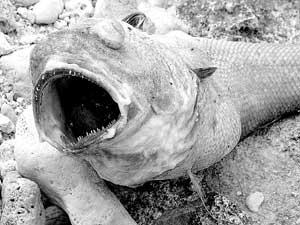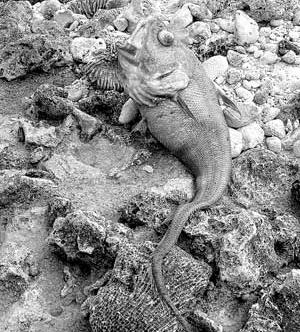What Is This Mystery Fish (#2)?
Posted by: Loren Coleman on January 15th, 2006
Our popular earlier attempt to decide what kind of fish or animal was on an old postcard has a more contemporary recent contender.
A strange looking sea creature of unknown identity washed ashore on Cayman Brac last weekend, reports the Cayman News.
The newspaper indicates that "Layman Scott found the fish while walking along the beach early Sunday morning [January 8, 2006]. It is roughly thirty inches long, more than half of which is a long, eel-like tail attached to a fish body. It has pale pink scales, pectoral fins, a dorsal fin and a small feathery fin on its belly."
I cannot imagine this one will go long unidentified by our Cryptomundo readers.
So what is it folks?
Here’s the photos as published in the Cayman News:


About Loren Coleman
Loren Coleman is one of the world’s leading cryptozoologists, some say “the” leading living cryptozoologist. Certainly, he is acknowledged as the current living American researcher and writer who has most popularized cryptozoology in the late 20th and early 21st centuries.
Starting his fieldwork and investigations in 1960, after traveling and trekking extensively in pursuit of cryptozoological mysteries, Coleman began writing to share his experiences in 1969. An honorary member of Ivan T. Sanderson’s Society for the Investigation of the Unexplained in the 1970s, Coleman has been bestowed with similar honorary memberships of the North Idaho College Cryptozoology Club in 1983, and in subsequent years, that of the British Columbia Scientific Cryptozoology Club, CryptoSafari International, and other international organizations. He was also a Life Member and Benefactor of the International Society of Cryptozoology (now-defunct).
Loren Coleman’s daily blog, as a member of the Cryptomundo Team, served as an ongoing avenue of communication for the ever-growing body of cryptozoo news from 2005 through 2013. He returned as an infrequent contributor beginning Halloween week of 2015.
Coleman is the founder in 2003, and current director of the International Cryptozoology Museum in Portland, Maine.










I’m not very intelligent when it comes to marine animals. But from the rounding of the mouth, it looks like it could be what they call “The Cookie Cutter Fish”
Rattail fish and also called a Grenadier fish and/or onion fish. Inhabits all oceans worldwide in depths from 2,100 – 5,440 meters and tend to go deeper as they grow. They hang just above the ocean floor.
I agree with blub, it’s clearly a Grenadier fish. One species that matches its location and size is the abyssal grenadier Coryphaenoides armatus.
The only thing I was going to add is that deep water fish that live in the dark water are often red because the red light never gets that deep. It gives them a black appearance to predators. Some krill shrimp from those depths look as red as cooked lobsters.
Don
I concur….mostly ‘mysterious’ since very few are seen by the public…not something that washes ashore particularly often.
It is NOT a rattail, also called the chimera, which looks more like an eagle than a used hand-grenade!
What it most likely is is a new type of angler fish, but with a long tail and no lure, making it more of an active hunter.
I just e-mailed in a link to a photo of a mystery thing, this time found in Oregon and about 30 feet long, so prepare to try to decide what it is y’all!
From Cayman Net News: 20 Jan. 2006
The mystery fish washed ashore is identified
Last week, The Bracker and Little Caymanian invited readers to try to identify a strange looking sea creature that washed up on the shores of Cayman Brac two weeks ago, where it was found by local fisherman Layman Scott.
Brac Marine Enforcement Officer Erbin Tibbetts said that, unfortunately, by the time he learned of the fish, it was too decomposed to send to Grand Cayman for exact identification.
However, Croy McCoy, a research scientist at the Department of Environment, told Cayman Net News that, based on the description and photos provided, he believes the fish is a member of the Family Macrouridae (Coryphaenoididae), better known as grenadiers or rattails.
These are found from Arctic to Antarctic, and there are thirty genera, with a total of 260 species. Mr McCoy added that most species are bathypelagic, occur in tropical to sub-tropical latitudes and live at depths between 200-2000 meters.
A selection of responses to the challenge was printed in the forum postings in Cayman Net News last Wednesday, 18 January. As the postings show, quite a few readers correctly identified the creature, demonstrating the superior intelligence of our readers.
There were also a number of spirited guesses, including the previously unheard of GW Bush fish. “Is it possible that it is a mutation or maybe a cross between two species?” asked one reader, while another speculated that it was a deep water eel, adding, “Also, I might add it does resemble my ex’s mother –in-law.”
Two other guesses: a “Vacdicarandicraous”, and a “Vibradicaracondis”, both apparently very old deepwater fish that prefer smaller fish of the same species but, nevertheless, are not considered cannibal.
Shamus, who has apparently gone fishing, said, “Actually, I don’t know what kind of fish this is. But, one thing on which we can all agree, it’s very interesting indeed.
“From the way the eyes are bulged outward from the sockets, the ‘feathery’ fin on the underside, the overall color, and long, slick tail, it can easily be recognized as a deep-sea creature.
“The pressure of say, 1,000 feet or deeper water would easily prevent the eyes from bulging from the sockets as such. The feathery under-fin would be used as a lure for enticing other fish, tricking them into thinking it is a meal.
“While the interested fish saunters closer to the ‘butterfly’-looking lure colorfully floating about in the water, however, our pictured fish remains in stealth mode, unseen. It sits very still and unnoticed as it blends with the surrounding rocks.
“Then, once the lured fish comes within range, our fish pushes off with its eel-like tail… lashing out snatching the lured fish with its shark-like teeth at speeds approaching that of Bruce Lee.
“The inward direction of the rows of teeth is designed to rip into the flesh of its struggling prey rather than allowing it to escape. How do I know all this, you might ask? I used to have a mother in law with the same bad habits. Have a nice day.”
Ah, I misused the name rattail for ratfish, which IS a name for the shark-relative chimera. I also knew nothing about the grenadier.